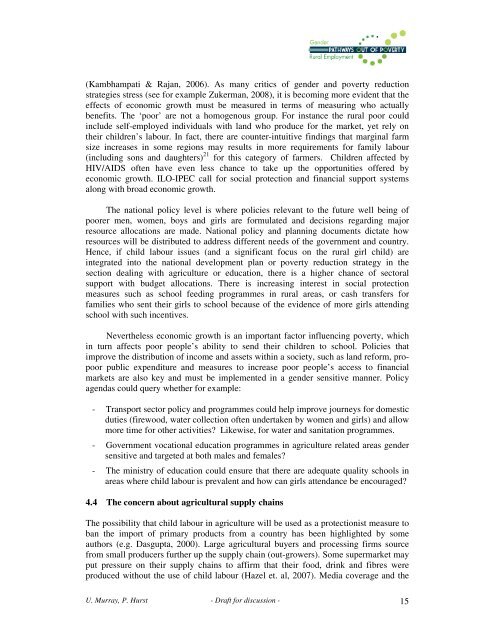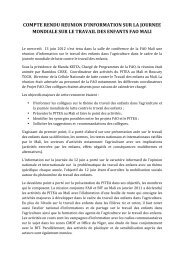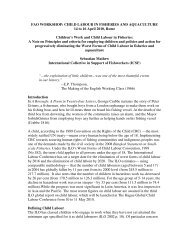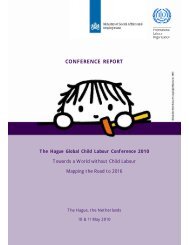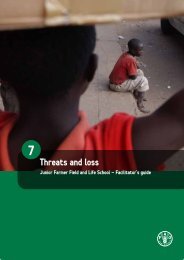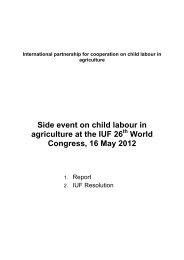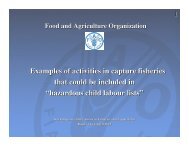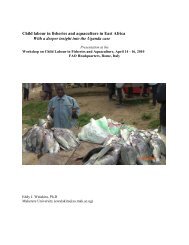Mainstreaming responses to the girl child in agriculture - Food ...
Mainstreaming responses to the girl child in agriculture - Food ...
Mainstreaming responses to the girl child in agriculture - Food ...
Create successful ePaper yourself
Turn your PDF publications into a flip-book with our unique Google optimized e-Paper software.
(Kambhampati & Rajan, 2006). As many critics of gender and poverty reduction<br />
strategies stress (see for example Zukerman, 2008), it is becom<strong>in</strong>g more evident that <strong>the</strong><br />
effects of economic growth must be measured <strong>in</strong> terms of measur<strong>in</strong>g who actually<br />
benefits. The ‘poor’ are not a homogenous group. For <strong>in</strong>stance <strong>the</strong> rural poor could<br />
<strong>in</strong>clude self-employed <strong>in</strong>dividuals with land who produce for <strong>the</strong> market, yet rely on<br />
<strong>the</strong>ir <strong>child</strong>ren’s labour. In fact, <strong>the</strong>re are counter-<strong>in</strong>tuitive f<strong>in</strong>d<strong>in</strong>gs that marg<strong>in</strong>al farm<br />
size <strong>in</strong>creases <strong>in</strong> some regions may results <strong>in</strong> more requirements for family labour<br />
(<strong>in</strong>clud<strong>in</strong>g sons and daughters) 21 for this category of farmers. Children affected by<br />
HIV/AIDS often have even less chance <strong>to</strong> take up <strong>the</strong> opportunities offered by<br />
economic growth. ILO-IPEC call for social protection and f<strong>in</strong>ancial support systems<br />
along with broad economic growth.<br />
The national policy level is where policies relevant <strong>to</strong> <strong>the</strong> future well be<strong>in</strong>g of<br />
poorer men, women, boys and <strong>girl</strong>s are formulated and decisions regard<strong>in</strong>g major<br />
resource allocations are made. National policy and plann<strong>in</strong>g documents dictate how<br />
resources will be distributed <strong>to</strong> address different needs of <strong>the</strong> government and country.<br />
Hence, if <strong>child</strong> labour issues (and a significant focus on <strong>the</strong> rural <strong>girl</strong> <strong>child</strong>) are<br />
<strong>in</strong>tegrated <strong>in</strong><strong>to</strong> <strong>the</strong> national development plan or poverty reduction strategy <strong>in</strong> <strong>the</strong><br />
section deal<strong>in</strong>g with <strong>agriculture</strong> or education, <strong>the</strong>re is a higher chance of sec<strong>to</strong>ral<br />
support with budget allocations. There is <strong>in</strong>creas<strong>in</strong>g <strong>in</strong>terest <strong>in</strong> social protection<br />
measures such as school feed<strong>in</strong>g programmes <strong>in</strong> rural areas, or cash transfers for<br />
families who sent <strong>the</strong>ir <strong>girl</strong>s <strong>to</strong> school because of <strong>the</strong> evidence of more <strong>girl</strong>s attend<strong>in</strong>g<br />
school with such <strong>in</strong>centives.<br />
Never<strong>the</strong>less economic growth is an important fac<strong>to</strong>r <strong>in</strong>fluenc<strong>in</strong>g poverty, which<br />
<strong>in</strong> turn affects poor people’s ability <strong>to</strong> send <strong>the</strong>ir <strong>child</strong>ren <strong>to</strong> school. Policies that<br />
improve <strong>the</strong> distribution of <strong>in</strong>come and assets with<strong>in</strong> a society, such as land reform, propoor<br />
public expenditure and measures <strong>to</strong> <strong>in</strong>crease poor people’s access <strong>to</strong> f<strong>in</strong>ancial<br />
markets are also key and must be implemented <strong>in</strong> a gender sensitive manner. Policy<br />
agendas could query whe<strong>the</strong>r for example:<br />
- Transport sec<strong>to</strong>r policy and programmes could help improve journeys for domestic<br />
duties (firewood, water collection often undertaken by women and <strong>girl</strong>s) and allow<br />
more time for o<strong>the</strong>r activities Likewise, for water and sanitation programmes.<br />
- Government vocational education programmes <strong>in</strong> <strong>agriculture</strong> related areas gender<br />
sensitive and targeted at both males and females<br />
- The m<strong>in</strong>istry of education could ensure that <strong>the</strong>re are adequate quality schools <strong>in</strong><br />
areas where <strong>child</strong> labour is prevalent and how can <strong>girl</strong>s attendance be encouraged<br />
4.4 The concern about agricultural supply cha<strong>in</strong>s<br />
The possibility that <strong>child</strong> labour <strong>in</strong> <strong>agriculture</strong> will be used as a protectionist measure <strong>to</strong><br />
ban <strong>the</strong> import of primary products from a country has been highlighted by some<br />
authors (e.g. Dasgupta, 2000). Large agricultural buyers and process<strong>in</strong>g firms source<br />
from small producers fur<strong>the</strong>r up <strong>the</strong> supply cha<strong>in</strong> (out-growers). Some supermarket may<br />
put pressure on <strong>the</strong>ir supply cha<strong>in</strong>s <strong>to</strong> affirm that <strong>the</strong>ir food, dr<strong>in</strong>k and fibres were<br />
produced without <strong>the</strong> use of <strong>child</strong> labour (Hazel et. al, 2007). Media coverage and <strong>the</strong><br />
U. Murray, P. Hurst - Draft for discussion - 15


